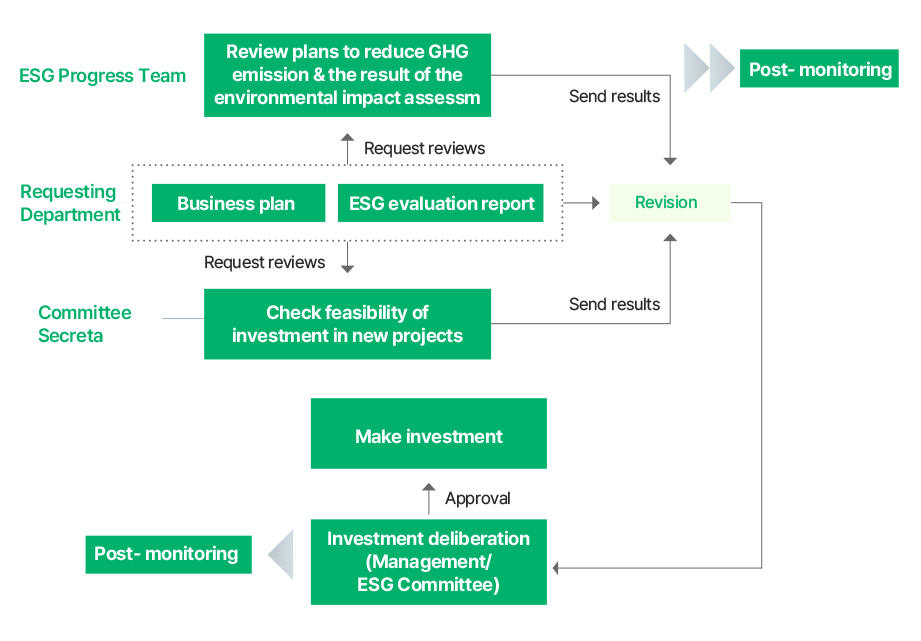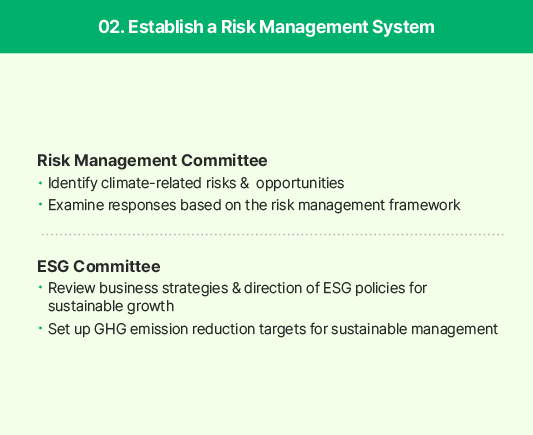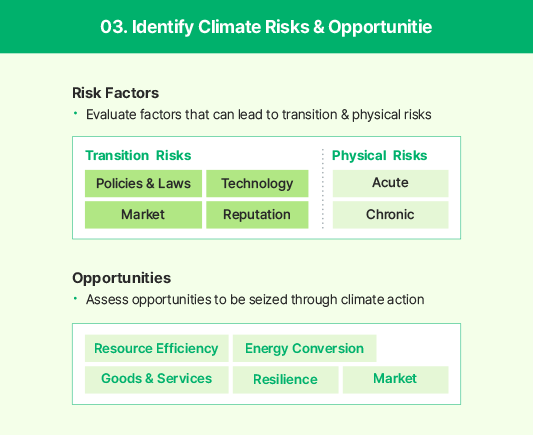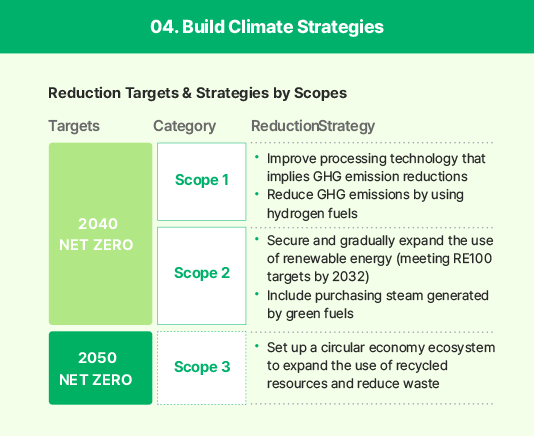Environmental
Environmental
Climate Change Response
Climate Change Response
Establishment of Climate Change Strategy
SK Chemicals has established a climate change strategy and publicly disclosed it to all stakeholders. Conducting a significant assessment considering all facilities and the Value Chain, we have identified risks and opportunities related to climate change. Subsequently, short-term, medium-term, and long-term strategies have been developed.
Establishment of Climate Change Response Strategy
Recognizing the need for systematic risk management for sustainable development and growth, SK Chemicals is building a climate change-related governance system. We systematically identify and analyze risks related to business, formulate strategies for each factor, and monitor implementation.
Developing Climate Change Response Strategy

Mobile image for Developing Climate Change Response Strategy. For more details, see below.
-
Climate Crisis Awareness
- Financial Loss from Climate Crisis
- Physical Risks
- Transition Risks
-
Establishment of Risk Management System
- Operation of Risk Management Committee
- Identification of climate change-related risks and opportunities
- Review of response measures through the risk management framework
- Operation of ESG Committee
- Review of business strategy and ESG direction for sustainable growth
- Setting greenhouse gas reduction goals for sustainable management
-
Identification of Climate Change Risks and Opportunities
- Risk Factors
-
Analysis of factors that may arise from transition and physical risks
-
Transition Risks
- Policy and Legal
- Technology
- Market
- Reputation
-
Physical Risks
- Acute
- Chronic
-
- Opportunity Factors
-
Analysis of opportunities that can be secured through climate change response
- Resource Efficiency
- Energy Source Transition
- Market
- Products and Services
- Resilience
-
Establishment of Climate Change Response Strategy
- Establishment of Reduction Targets and Implementation Strategies by Scope
-
2040-2050 Scope 1, Scope 2, Scope 3 Net Zero Reduction Strategy Objective Category Reduction Strategy 2040 Net Zero Scope1 - Process technology improvement with greenhouse gas reduction technology
- Greenhouse gas reduction through hydrogen fuel usage
Scope2 - Gradual expansion and securing of renewable energy (targeting RE100 by 2032)
- Application of steam produced with environmentally friendly fuel
2050 Net Zero Scope3 - Expansion of recycled material usage and waste reduction through establishing a circular economy ecosystem
ESG Committee
- Setting goals for ESG-related activities across management and monitoring detailed execution results and plans
- Identification of risks and opportunities in business areas through the risk management framework, and reviewing strategies for financial and non-financial risks and opportunities
-
ESG Committee
(Independent Director Park Jung-soo (Chairman), Ahn Yang-ho /
Internal Director Ahn Jae-hyun)
-
Purpose of Establishment
- Identifying topics and issues related to ESG operation
- Advising and reviewing business strategies and ESG directions for sustainable growth
- Setting sustainable management goals considering environmental and social responsibility management policies
- Execution and improvement of risk management framework
- Reviewing strategies for financial and non-financial risks and opportunities
-
Agenda
- Reviewing short and medium to long-term ESG promotion plans and activities
- Reviewing results and plans for the current year's progress in ESG promotion tasks and projects
- Reviewing key non-financial risk factors, issue matters, and response strategies
- Reviewing communication matters with stakeholders related to domestic and international ESG evaluations
- Reviewing support measures for ESG competency development and internalization
- Reviewing matters related to environmental and social issues presented by the chairman
- Reviewing other significant issues related to ESG or strategy delegated by the board of directors
Company-Wide Risk Management System and Integrated Climate Change Risk Management System
- Identification and assessment of risks and opportunities affecting overall management due to climate change
- Continuous monitoring of selected core challenges, progress, and plans, ensuring risk management beyond legal compliance
- Appointment of a Chief Risk Officer (CRO) to report the progress of risk tasks to the board of directors every quarter
Climate Change Scenario Analysis
- Performing scenario analysis for potential financial impacts of potential risks due to climate change, following TCFD recommendations, and proactively responding to transition and physical risks
- (Transition Risk Scenario) IEA 1.5℃ NZE Scenario, NGFS Below 2℃ Scenario, and Above 3℃ Scenario
- (Physical Risk Scenario) IPCC RCP 2.6-8.5 Scenario
- Developing resilience strategies based on financial impact analysis results for each scenario
Establishment of Sustainable Investment Strategy
SK Chemicals classifies businesses with a high likelihood of environmental and social issues arising from climate change. During investment review, the Investment Review Committee reviews the ESG review report to minimize the negative impact of SK Chemicals's investments on the environment and society. After investment, post-monitoring focuses on measures to reduce environmental and social risks based on the ESG review report.
Investment Decision-Making Process


-
-
- ESG Promotion Team
- Review of greenhouse gas reduction plans and environmental impact assessment results
-
- Proposing Department
- Business plan
- ESG evaluation report
-
- Investment Review Committee Secretariat
- Review of investment feasibility for new business projects
-
-
Modification/Improvement
-
Investment Review (Management/ESG Committee)
-
Investment Execution




